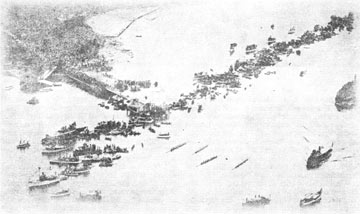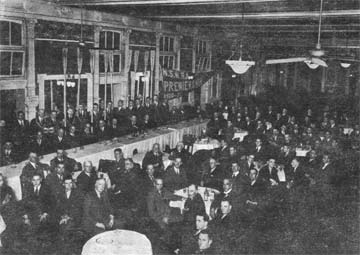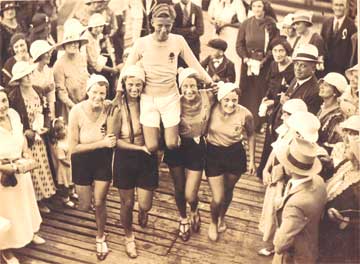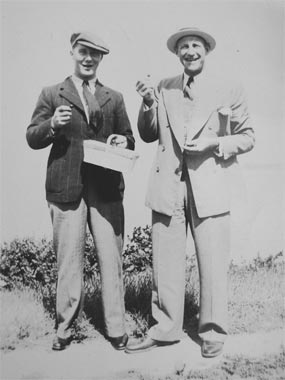
Sydney Rows
A Centennial History of the Sydney Rowing Club, 1970, by A L May
Table of Contents
Chapters
- Preliminaries: before 1870
- Foundations: 1870-1880
- New Clubs: 1880-1890
- The Amateur Question: 1890-1900
- Sydney on Top: 1900-1910
- Henley and War: 1910-1920
- Pearce and Mosman: 1920-1930
- Financial Problems: 1930-1940
- War and Wood: 1940-1950
- Strength and Stability: 1950-1960
- On Top Again: 1960-1970
Appendices
8. Financial Problems: 1930-1940
England declared war on Germany on 3 September, 1939 and the sport of rowing in Australia was, of course, among the many casualties. It took some time, however, for the full effects to be felt. One of the first winners of the new season proved to be the young Kevyn Webb of Haberfield who secured the Walker and Hall Cup. It was Haberfield, too, which won the champion fours of NSW, scoring a 6 length win over the Sydney crew of Boulton, Bradley, Dixon and Jay.
In the champion eights, however, Haberfield bowed by 4 lengths to Balmain, coached by Cec Pearce and including George Neilson at 7. Merv Wood, now trying his hand at sculling, beat Turner by 100 yards in the championship, while Nepean won its first State championship in the lightweight fours.
Consideration was now given to the 1940 King's Cup, due to be held in NSW. A postal vote found three States in favour of a motion to postpone the event till 1941, and three against. In accordance with the rules, the proposal was lost and the race was, therefore, to be held. However, the issue was decided finally by NSW which relinquished the right to conduct the event in 1940. The race thereupon lapsed.
The NSWRA did decide to go on with a tour of NZ during the Centennial Celebrations there early in 1940. The visit was the first by an eight to NZ and great interest was aroused. Raper again made the selections and the final crew contained Gordon Clubb, Paul Montgomerie and Brin Jay from Sydney, three men from Mosman and one each from Haberfield and North Shore. Bill Kerr was cox and Fred Cronin of Drummoyne coach, with Kevyn Webb, aged only 16, selected as sculler.
At the first of the four regattas, NSW won the senior eights by 3 1/2 lengths but, at each of the next two, they finished a close second to the Wanganui Union eight. The last race, at Wellington, was the champion eights of NZ and this time NSW got up to beat Aramoho by 3/4 length with Wanganui only third. Bob Smith, the NZ champion, proved too good for Webb and for Clubb, who also competed in the sculling events.
A most successful decade for NSW rowing now came to an end. Of eight King's Cups held, NSW had won four and gained four seconds, while Turner and Pearce had each won four President's Cups to give NSW a clean sweep. Melbourne oarsmen had also come almost to dread entries from NSW crews - and particularly from NSW scullers - in Henley-on-Yarra, while several overseas visits had been made.
A number of variations in rowing style were seen in Sydney during the period. In the early years of the decade, the ideas of Steve Fairbairn began to gain followers in Australia. Fairbairn differed from the so-called "orthodox" style, which originated with fixed-seat rowing, in a number of main fields: instead of a smart opening of the body at the beginning, he taught his crews to drive at the blade and to let the body and slide take care of themselves; he urged a rounded movement of the hands at the finish, not rectangular; and in place of the "lively recovery", he taught a sit back at the finish with only the hands being flicked away quickly. Only two Sydney clubs were still rowing the distinct shoulder lift by 1936, with the leg drive to move the blade into the water being emphasized.
There were, however, many differences in the styles employed. In Dr. Parkes' crews, for example, crew members all worked towards their swivels, their bodies taking a "natural course" with some swinging back to a very great angle. There was no doubting, however, the power of the beginning and the length of the stroke itself. The net result at the end of the decade was the lamentation that "N.S.W. appears to be developing a system of chaotic individualism in coaching". Frequent calls to return to the standard style of previous years were heard.
Other Developments
Three schools only shared the GPS championships between them in the 'thirties. The Head of the River in 1931 was a great battle, with St. Joseph's and High fighting for the lead at the finish. When Shore staged a great effort, however, neither had anything left and Shore won by 3 feet from High with Joeys 3 feet further back. Some consideration was given to not holding the race in 1932, but it went on and this time St. Joseph's, coached by Williams, got to the front and stayed there with Shore in second position. After the event, a bitter row between the Referee newspaper, Ossie Wood, the umpire, and the AAGPS itself broke out over the course of the Referee's launch at the race.

Panoramic view of the finish of the GPS Regatta 1934.
St. Joseph's retained the title in 1933 but Grammar, coached by A. N. Finlay, took the title in 1934. Shore was second both times, but was unlucky in the latter year, finishing with seven men only. In 1935, Grammar almost did it again, but Shore managed to get past them on their third effort to again take the title.
Opinion by now was strongly in favour of the GPS moving their regatta to the Nepean to avoid the many problems of the Parramatta. In 1936, the big step was made, thus allowing all eight crews to start in the one race without the necessity of heats. Joeys celebrated the event with a win, with Grammar second and Shore third. The site seemed now to be permanent. Shore was too good in each of 1937, 1938 and 1939, although High, taken over by Frank Nichols in 1938, was second by only 3 feet that year and was second again in 1939.
In 1938, High also became the first-ever school crew to win the Riverview Gold Cup although St. Joseph's repeated the effort in 1939. Grammar won in 1940 with High second for the third year in a row and Shore third. Over the decade as a whole, Len Robson's success with his Shore crews was quite outstanding: five wins, three seconds and two thirds. There were no developments of any significance during the decade concerning rowing by high schools.
Many matters of interest again came before the AARC and the NSWRA during the decade. In 1932, the Council considered a motion to establish a fund for sending rowing and sculling representatives to the Olympic Games and other overseas regattas by imposing a levy of sixpence on members of all associations but it was defeated.

A smoke concert organised by the NSWRA and the Union of Old Oarsmen to mark the winning of the 1933 King's Cup and sculling championships
A major move at the 1934 AARC meeting was deletion from the amateur definition of the clause debarring men "working in or about boats for money or wages" (and the NSWRA promptly dropped this condition as well). The RA gave long consideration in 1932 and 1933 to changes in its point-scoring system - including the awarding of four pennants: maiden, junior, senior and premiership - but agreement could not be reached on a suitable alteration.
In 1938, the fostering of rowing on the northern rivers was also further debated. While agreeing to the desirability of affiliating as many clubs as possible, the Association felt control of racing would best be handled by a sub-branch of the Association in the northern rivers. No such sub-branch was, however, formed. Judge Backhouse accepted the presidency of the Association in 1930. A regular attender at regattas and a keen supporter, he held the position until his death in 1939. Judge Alex Thomson, the former secretary of the Association, succeeded him.
The position of deputy president was established in 1939 with Nat McDonald being the first incumbent. Harry Alderson occupied the chairman's seat throughout the decade with Buckley similarly acting as treasurer. Laurie Raper was secretary for the first five years, being succeeded by Bill Wilson for two years and by John Rook from 1937/38. A significant organizational change took place in 1936, with the establishment of the "Executive Committee" consisting of the Association's officers. Meetings in advance of those of the General Committee commenced and recommendations regarding transfers were soon being made by the new body. Regular social events do not appear to have been held, although gala sports days were conducted at St. Ignatius' College from 1931 to 1934, with rowing, swimming, cricket and athletic events being held.
Keen competition continued among women rowers in NSW. Sydney Ladies' was the dominant club. In 1932, for example, the club won the NSW Women's Rowing Association's championship (for the fifth year in a row) and also won the two pennants, senior and junior, given that year for the first time. Strong competition came from the three other clubs, the YWCA, Balmain and Abbotsford. A feature of the Sydney Ladies' regatta in 1933 was a ladies' eight event, the first rowed in NSW. The Sydney crew rowed-over. The interstate competitions continued each year and NSW had considerable success. In the first five years of the decade, the State crew won four times and came second (to Victoria) in the other. Thereafter, however, success proved much harder to attain.

Victorious 1934 NSW Women's Four after their win
Tasmania won three of the remaining events and Victoria two. WA was the only State not to take part. The highlight of the 1938 interstate race, rowed in Sydney, was the entry of an English four. The visit created much interest, with the English ladies winning the event by 2 lengths and going on to complete their Australian trip with an unbeaten record.
A new star soon dominated the professional sculling scene. Ted Phelps was world champion as the decade opened, and he successfully defended his title against Ernest Barry in October, 1930 and Major Goodsell, by now an American citizen, in September, 1932.
His next match was in September, 1933 in Toronto, Canada, and against . . . Bob Pearce. Before a crowd of about 70,000, Pearce won by a "tremendous distance"- so far that it was doubted, in fact, if further matches could be arranged for high stakes. George Towns lodged a challenge on behalf of Snowy Burns, the Australian champion, but Pearce was unable to return to Australia for business reasons.
The next challenge was arranged for the Canadian National Exhibition in August/September, 1934 and it involved Pearce, Eric Phelps (Ted's young brother), Ernest Barry and Bill Millar, the US amateur champion who had turned professional. Two heats were rowed, with Pearce and Millar winning through. In the final, Pearce beat Millar by 15 lengths for another easy win. (The two met again in a series of races in mid-1935 but not, apparently for the championship. Over varying distances from 1/2 mile to 3 miles, each won two events.)
In 1937, Evans Paddon, the son of Jim Paddon, won the Australian title from Burns. Pearce then offered to return to Australia for a match with Paddon on the Parramatta if ₤500 expenses could be found for him. A little later, he offered to pay Paddon's return fare to Toronto in 1938 for a race for the title and ₤500 aside. Paddon, who had just defended his title against George Cook, accepted the challenge. In the race itself, Pearce scored an easy win, going out to about 8 lengths ahead and then just paddling.

Evans Paddon (left) and Bob Pearce (right) in Ontario in 1938
While there were rumours of further challenges, particularly from Joe Burk, the American, none eventuated before the end of the decade.
Interest in professional sculling in NSW had been very keen. In the early years of the decade, the Pittwater Aquatic Club and the Parramatta River Professional Sculling Club (re-established in 1932) conducted a range of events, while they were joined by the Cronulla Professional Sculling Club in 1935. The NSW Professional Rowing and Sculling League also became active again. A number of promising amateur scullers - including Max and Jack Fisher, Bert Goulding and Howard Holden-raced as professionals at this time. Professional sculling suffered a great loss in 1935 with the death, at 84, of Bill Beach. An appeal was opened and, in 1938, a grey granite monument was unveiled to his memory in Cabarita Park, close to the scene of some of his many triumphs.
